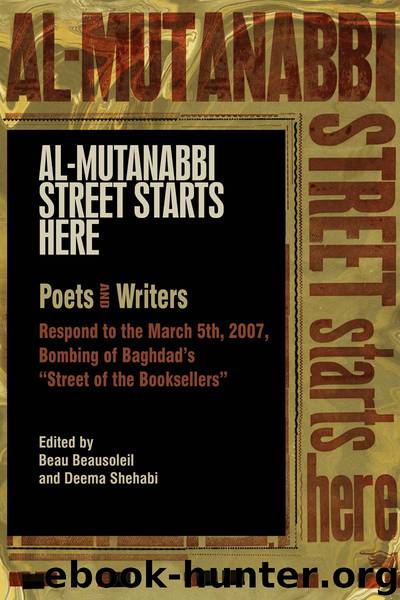Al-Mutanabbi Street Starts Here by Beau Beausoleil

Author:Beau Beausoleil
Language: eng
Format: epub
Publisher: PM Press
Published: 2012-02-26T16:00:00+00:00
Remembering al-Mutanabbi
Thomas Christensen
Some day we’ll stop making the goddam funeral pyres and jumping into the middle of them. We pick up a few more people that remember, every generation. —Fahrenheit 451
As the fifteenth century was drawing to a close, William Caxton, England’s first printer, traveled to the Flemish city of Bruges. Today the city, with its late medieval architecture and meandering cobbled streets, seems a museum piece, but then it was a lively trading center where Italians, Germans, Spaniards, and others met and exchanged goods—and ideas. Arts and culture flourished, and new technology was everywhere. Visitors were assured of eating well thanks to the invention of drift nets, which resulted in an abundance of seafood. Followers of Jan van Eyck and Hans Memling were filling the city with paintings in a medium new to Northern Europe, oils. And the printing press with movable type—the machine on which Johannes Gutenberg had printed his forty-two-line Bible a couple of decades before— was changing the intellectual life of the city. (Printing on movable metal type was well established in Korea, and information about it could have traveled through the vast Mongol empire to West Asia, and from there to Europe.)
There in Bruges, at a table overlooking a foggy canal, over a meal of mussels and beer, Caxton would discuss the new printed texts with scholars and artists who were arriving from all across Europe. Among those joining him would have been Colard Mansion, a Flemish scribe who printed the first book using copper engravings, as well as the first books in English and French. Also at the table would have been Anthony Woodville, the second Earl Rivers, an English Francophile and translator. Woodville had recently completed a translation of a French text called Les Dits Moraulx des Philosophies. The book was a compendium of the wisdom of ancient philosophers. Would Caxton have a look at it?
The English printer set about editing and proofreading the translation. In Bruges, working with Mansion, he mastered the art of printing, and when he returned to England he established a press there, and made Dictes and Sayings of the Philosophers the first dated book printed in England.
And so, the seed of free speech that was planted by followers of Muhammad found fruit at the very inception of bookmaking in England— for the French version of Dictes and Sayings of the Philosophers was itself a translation from Latin. It, in turn, was a translation of an Arabic text, Muhtar al hikamwamahasin al kalim, written in the eleventh century by Abul Wafa Mubasshir ibn Fatik, an Egyptian emir.
The Islamic world was then and remains today one of the great centers of book production. Arabic calligraphy lends itself to textual decoration, and demand for glorious Qur’ans spurred book arts to unprecedented heights. But another factor was equally important in the flourishing of Islamic bookmaking—its tradition of freedom of speech.
Omar, the second caliph, whose caliphate began just two years after the death of Muhammad himself in the seventh century, declared that the weak must be allowed to “express themselves freely and without fear.
Download
This site does not store any files on its server. We only index and link to content provided by other sites. Please contact the content providers to delete copyright contents if any and email us, we'll remove relevant links or contents immediately.
| Arms Control | Diplomacy |
| Security | Trades & Tariffs |
| Treaties | African |
| Asian | Australian & Oceanian |
| Canadian | Caribbean & Latin American |
| European | Middle Eastern |
| Russian & Former Soviet Union |
The Secret History by Donna Tartt(18752)
The Social Justice Warrior Handbook by Lisa De Pasquale(12082)
Thirteen Reasons Why by Jay Asher(8739)
This Is How You Lose Her by Junot Diaz(6702)
Weapons of Math Destruction by Cathy O'Neil(6085)
Zero to One by Peter Thiel(5638)
Beartown by Fredrik Backman(5548)
The Myth of the Strong Leader by Archie Brown(5375)
The Fire Next Time by James Baldwin(5200)
How Democracies Die by Steven Levitsky & Daniel Ziblatt(5096)
Promise Me, Dad by Joe Biden(5036)
Stone's Rules by Roger Stone(4989)
100 Deadly Skills by Clint Emerson(4798)
A Higher Loyalty: Truth, Lies, and Leadership by James Comey(4797)
Rise and Kill First by Ronen Bergman(4658)
Secrecy World by Jake Bernstein(4594)
The David Icke Guide to the Global Conspiracy (and how to end it) by David Icke(4557)
The Farm by Tom Rob Smith(4404)
The Doomsday Machine by Daniel Ellsberg(4375)
